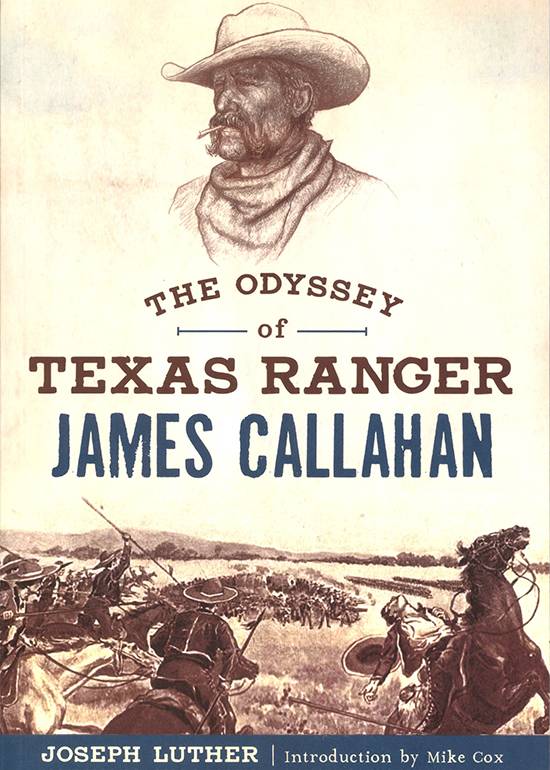Rough and Ready

The Odyssey of Texas Ranger James Callahan
By Joseph Luther
Mt. Pleasant: Arcadia Press. 2017.
192 pp. $21.99 paper.
Reviewed by
Joseph Fox
The consensus among Texas historians on the 1855 Callahan Expedition into Mexico is that it was a ruse to retrieve runaway slaves under the auspice of launching a punitive Texas Ranger raid led by James H. Callahan against Lipan Apaches. Texas historian Joseph Luther adds context to the question by writing the first biography on Callahan’s life, The Odyssey of Texas Ranger James Callahan. Although Luther’s narrative of Callahan’s life does not revolve around the motives for the Callahan Expedition, it does try to provide James Callahan a fair examination as an individual caught up in historical forces both beyond his control and of his own making.
Luther begins his story in 1835 when Callahan is enlisted to help Americans fighting in the Texas Revolution against the Mexican government. Serving in the Georgia Battalion, Callahan fought against the Mexican Army at Refugio, was captured but avoided execution at Goliad, escaped, and later fought at the Battle of San Jacinto. After the Revolution, Callahan became a founding citizen of Guadalupe and Blanco counties, but his skill as a soldier led him to become a Texas Ranger where he fought alongside Jack Hays and Matthew Caldwell. If judged only by his time during the Texas Republic, his service in protecting the American frontier against invading Mexican armies and Comanche raiders would merit celebration and a favorable legacy if not for the tangled web of the 1850s.
In narrating the Callahan Expedition, Luther describes in chronological order the Lipan Apache raids that precipitated demand from Texas Governor Elisha Pease for Ranger retaliation, the slave-catching expedition by Ranger William R. Henry (that Luther argues occurred separately), Callahan’s march to Eagle Pass and entry into Mexico with permission of the alcalde of Piedras Negras to hunt Apaches, the subsequent surprise battle against an army of Seminoles and Mexican soldiers, Callahan’s retreat and defense of Piedras Negras under siege (where Luther quotes from a witness that “if they [the Rangers] must die then they would die as gamely as ever Texas had died”), and his burning of Piedras Negras to cover his retreat. Although the account comes off as a disaster spurred by Texan bravado, Luther portrays Callahan as an honorable commander who stayed true to his mission of pursuing Lipan Apache raiders. The only slave catchers, according to Luther, in the Callahan Expedition were from the group of rangers led by Henry that had previously been expelled by Mexican authorities only to rendezvous with Callahan who needed reinforcements for his mission. The presence of Henry and his slave catchers was exploited by Mexican authorities in the fallout of the expedition as diplomatic leverage against the United States.
Whether or not the reader finds Luther’s argument compelling, a strong point in the book is Luther’s passion for Texas history reflected in his extensive use of archeological reports as well as a wide array of primary and secondary sources on people, frontier towns, trade routes, landmarks, weapons, and tactics. A reader, wanting to learn more about the peoples of Texas and Mexico’s borderland would be well-served to read this book. The fault in Luther’s writing is that he comes off as too sympathetic to Callahan and neglects areas that might be inconvenient. For instance, Eagle Pass resident Jessie Sumpter in his memoir Paso Del Aguila: A Chronicle of Frontier Days on the Texas Border stated that Callahan was “the owner of most of the Seminole Negroes (those Seminoles were all runaway slaves)” and launched the expedition to recover them. Although mention in a memoir that Callahan was a slave owner should be open to skepticism, it receives no mention in this book. Readers should also try to gain the perspective of people who were on the receiving end of the Callahan Expedition such as Mexican liberal, José María de Jesús Carvajal. Carvajal, whose life was recently documented by borderland historian Joe Chance in his book José María de Jesús Carvajal: The Life and Times of a Mexican Revolutionary, claimed $21,792 in damages after Callahan’s Rangers burned his house in Piedras Negras and was not reimbursed by the United States government. Whether or not Luther succeeds in setting the full record straight on James Callahan, it may be best for the reader to decide. Perhaps the best point Luther makes in writing about James Callahan’s life is to not judge a man’s life by a moment but in its entirety.
Joseph Fox is the Associate Education Officer at the Museum of South Texas History in Edinburg, Texas, and he holds a MA in history from Texas State University in San Marcos, Texas. His areas of research include Borderlands and Texas Music History. He has written articles for the Handbook of Texas History, a historical marker for the Texas Historical Commission. His Master’s Thesis was on the relationship between Lone Star beer and the 1970s Austin music scene.
